Oak and Iron: What Uniform Do I Wear Today?
By Mitch Reed
Now that our own has filled you in on the final rules for Oak and Iron, this article will talk about the how important the factions are to the game. Much like Blood and Plunder, the folks from have given us a lot of flavor from the period and once again they have given their players some great options when creating their force. Oak and Iron has five major factions to choose from, France, England, Spain, and Holland and of course the Pirates. Each of these factions has their own strengths and weaknesses and a lot to consider when you build your squadrons.
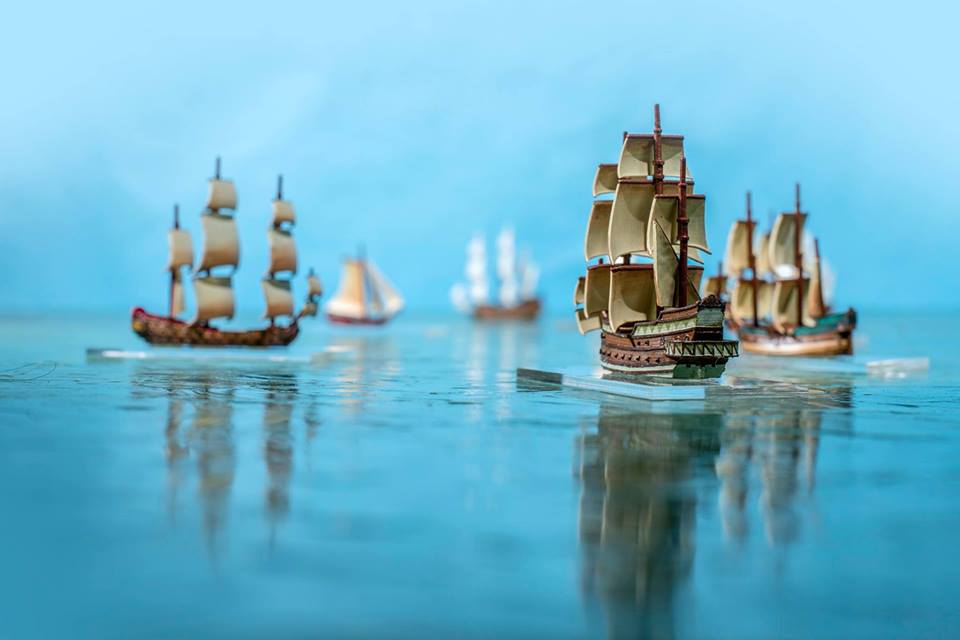 First of all, choosing a faction is a big deal in the game; not only does each have their own special rules, but it also dictates the leaders (Admirals), upgrades and even effects the type of initiative cards you can use to fill up your initiative deck. This ensures that each faction plays differently and has a unique flavor that will make the game fun to play.
First of all, choosing a faction is a big deal in the game; not only does each have their own special rules, but it also dictates the leaders (Admirals), upgrades and even effects the type of initiative cards you can use to fill up your initiative deck. This ensures that each faction plays differently and has a unique flavor that will make the game fun to play.
While many gamers will easily understand how selecting a faction and taking their unique leaders adds a national flavor to the game, however when it comes to how this affects your initiative hand we are in new territory.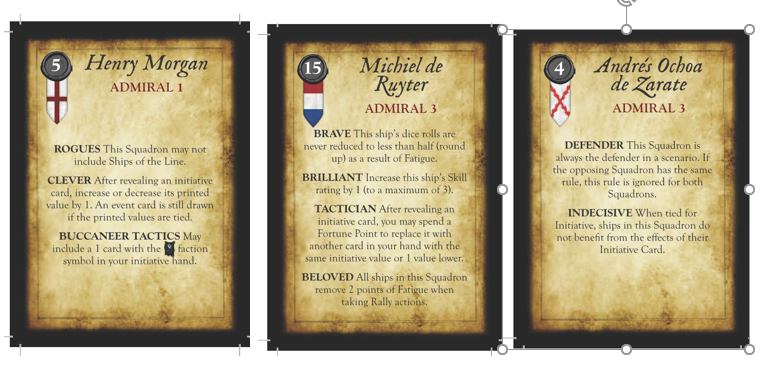 In Oak and Iron, players bid each turn for the initiative which determines the order in which the players move and engage in combat. Each player builds an initiative deck of at least five cards, with up to three more depending on the “Admiral Value” of their squadron’s leader. Some of the cards you can select for this hand are only available for certain factions and when played during the bidding they can give a player some really great bonuses.One last thing that needs to be pointed out is that unlike Blood and Plunder, gamers do not have to focus on building one faction, since, for the most part, any faction can take any mixture of ships. I plan to paint my ships in a neutral color and not apply the sticker flags that come in the Kickstarter so I can play each of the factions.
In Oak and Iron, players bid each turn for the initiative which determines the order in which the players move and engage in combat. Each player builds an initiative deck of at least five cards, with up to three more depending on the “Admiral Value” of their squadron’s leader. Some of the cards you can select for this hand are only available for certain factions and when played during the bidding they can give a player some really great bonuses.One last thing that needs to be pointed out is that unlike Blood and Plunder, gamers do not have to focus on building one faction, since, for the most part, any faction can take any mixture of ships. I plan to paint my ships in a neutral color and not apply the sticker flags that come in the Kickstarter so I can play each of the factions.
The English
This period was where the Royal Navy really started to come into its own and laid the groundwork for their dominance in the next century. English ships get Skilled Sailors and Expert Gun Crew which are not bad skills to have.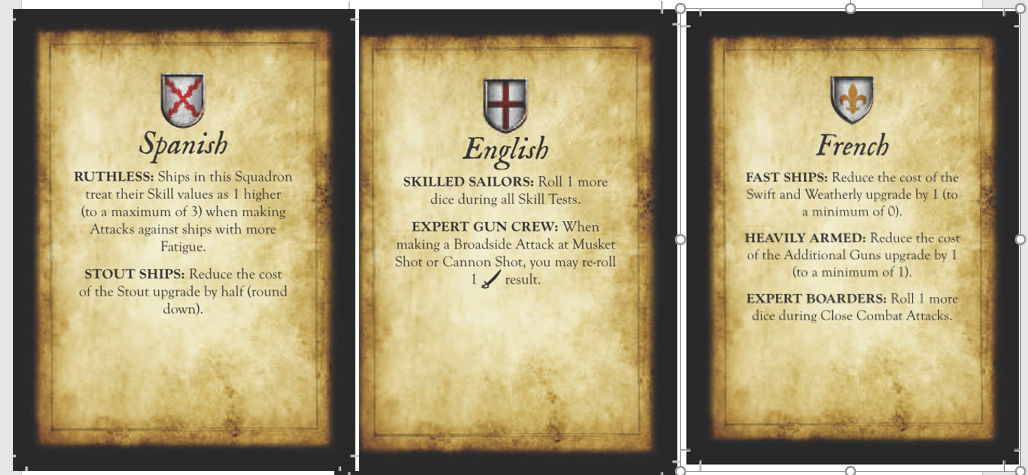 The English do get some great Admirals such as Benbow, Monck, and Morgan who for their cost are some of the best in the game. The English specific initiative cards really spotlight gunnery and squadron maneuver which is the same theme for the admirals. The English are for a player who wants to move their ships in-line and use their cannons to subdue their opponent with shot after shot.
The English do get some great Admirals such as Benbow, Monck, and Morgan who for their cost are some of the best in the game. The English specific initiative cards really spotlight gunnery and squadron maneuver which is the same theme for the admirals. The English are for a player who wants to move their ships in-line and use their cannons to subdue their opponent with shot after shot.
The Pirates
This is a very interesting force. Its only drawback is that you cannot take ships of the line in your squadrons, which may mean you will lack the firepower other players can bring to the table. To make up for this you can choose initiative cards from the Pirate labeled cards and one other faction, so you will get a lot of flexibility here.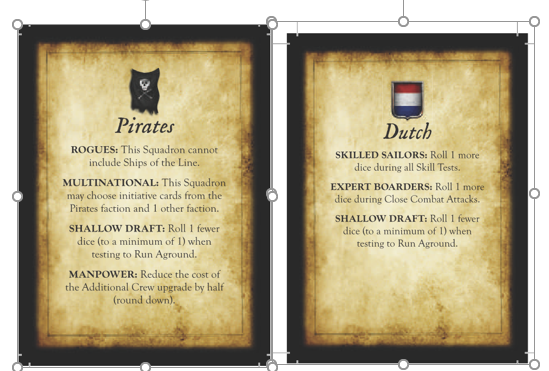 They also get cheaper Manpower upgrades and suffer less damage when running aground. For Admirals, you get Hamlin, Jennings, Roberts and Teach, each of them have a very different flavor and give you some of the best options when building a force because they combine tactical prowess, luck, and aggression. This faction only gets two unique initiative cards, however, they get to pick one faction to add to their card pool.
They also get cheaper Manpower upgrades and suffer less damage when running aground. For Admirals, you get Hamlin, Jennings, Roberts and Teach, each of them have a very different flavor and give you some of the best options when building a force because they combine tactical prowess, luck, and aggression. This faction only gets two unique initiative cards, however, they get to pick one faction to add to their card pool.
The French
The French are the force you want if you are aggressive. They get “Fast Ships”, “Heavily Armed” and “Expert Borders” special rules. For admirals, they get d’Estrees, Bart and Dugay-Trouin whose skills also favor the bold player. The French initiative cards are about speed and violence at close range. If attacking your enemy up close and boarding them is your thing then the French is the force you want to play. The Spanish
The Spanish
The Spanish get the “Ruthless” and “Stout Ships” special rules and have de Pardal, de La Cerda and de Zaratee each of which leads me to believe that the Spanish are for the more cautious and defensive-minded player. This theme is also represented in their initiative cards which favor defense and resiliency. I think players new to age of sail games should really consider playing this faction since it will not force you into mistakes with aggressive action.
The Dutch
Despite its size, the Dutch were among the world’s best seamen during this period. They get the “Skilled Sailors”, “Expert Boarders” and “Shallow Draft” special rules. For admirals, they have de Ruyter, Crijnssen and Evertsen who are very balanced much like the flavor of the entire Dutch faction and is also evident in their initiative cards. The Dutch really represent a “jack of all trades”, having no weaknesses or real focus on any one aspect of naval warfare. The Dutch would be a selection for those who want to game all of the aspects found in the mechanics of Oak and Iron.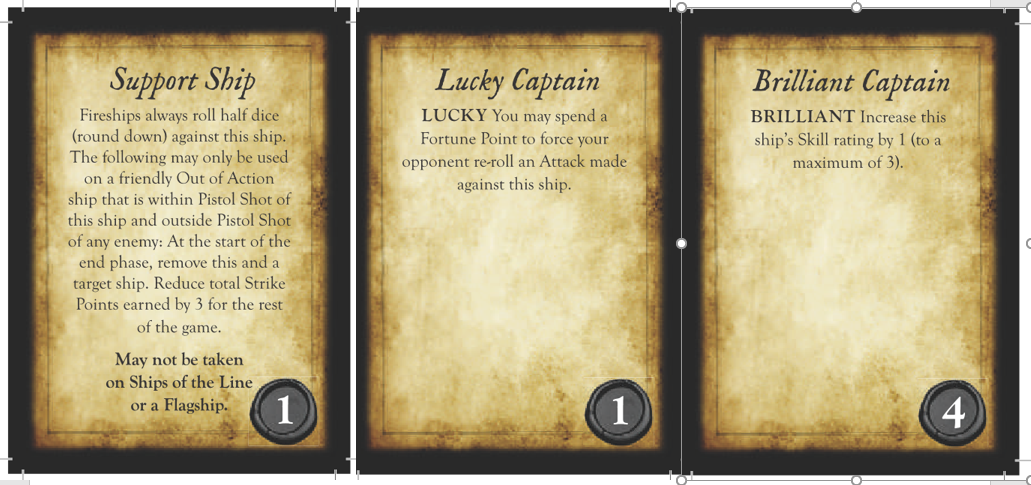 The Upgrades
The Upgrades
The game has a bunch of upgrades that are not tied to the ship cards and aim to further specialize your force. Some are faction-specific such as Corsairs (Spain & Pirates), Buccaneers (England, France & Pirates), Kapers (Dutch & Pirates) and Stede Bonnet who is only available for the Pirates. So as stated before, the selection of a faction if a key component of this game. These upgrades tend to focus on the individual ship captains and how they trained their crews and modified their ships. Some of these upgrades have negative values so you can use the points they shave off of your squadron’s total to spend elsewhere in your force. Upgrades and Admirals will cost you points to use, however, both are optional.
The Ships
The ship types are very expansive, you have six choices when it comes to ships of the line and a further six with lighter patrol and commerce ships. Those of us who got in on the Kickstarter will also get two extra ships, the Revenge and Queen Anne’s Revenge to further bolster our Pirate squadrons. Unless you are playing the Pirate faction or pick a leader with the “Rogue” trait you are free to select any combination of ships in the game. Right now the rules state the game is played at three different point levels, Patrol (50-Pts), Skirmish (100-Pts) and Engagement (200-Pts) which are recommendations for organized play. Playing at the lower end makes fielding the 1st and 2nd Rate ships impossible and very hard with a 3rd Rate, so at the Patrol point level you are looking at ships on the low end like Sloops, Corvettes, and Frigates. Even with these smaller ships, the right faction, upgrades and even an admiral can make the small ships very deadly.
Unless you are playing the Pirate faction or pick a leader with the “Rogue” trait you are free to select any combination of ships in the game. Right now the rules state the game is played at three different point levels, Patrol (50-Pts), Skirmish (100-Pts) and Engagement (200-Pts) which are recommendations for organized play. Playing at the lower end makes fielding the 1st and 2nd Rate ships impossible and very hard with a 3rd Rate, so at the Patrol point level you are looking at ships on the low end like Sloops, Corvettes, and Frigates. Even with these smaller ships, the right faction, upgrades and even an admiral can make the small ships very deadly. In looking over the ships you have a lot of discretion in upgrading them by adding extra crew, guns, Crew Skill, Sweeps, reinforced hulls (Stout) or modified sails (Weatherly & Swift). Taking a lot of these upgrades makes the ships very costly and you can pick upgrades that maximize your faction’s skill areas or to protect them from a weakness you want to prevent the enemy from exploiting. Also, many of the ships have special rules which make them handle and operate as they did historically.
In looking over the ships you have a lot of discretion in upgrading them by adding extra crew, guns, Crew Skill, Sweeps, reinforced hulls (Stout) or modified sails (Weatherly & Swift). Taking a lot of these upgrades makes the ships very costly and you can pick upgrades that maximize your faction’s skill areas or to protect them from a weakness you want to prevent the enemy from exploiting. Also, many of the ships have special rules which make them handle and operate as they did historically.
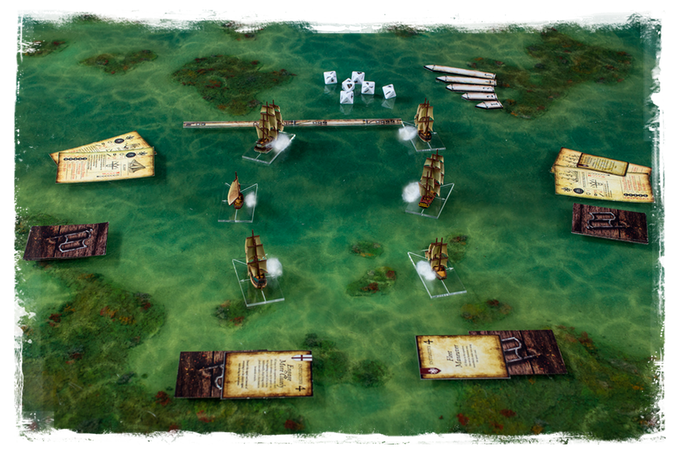 I can see a French player at the Skirmish level taking a lot of light and fast ships with an admiral such as Jean Bart and selecting initiative cards like “Zeal” and “Elan” and just take the fight right to the bigger enemy ships. Conversely, a Spanish player may take larger ships and upgrade them to be harder to kill and sit back and wait for your enemy to take a course of action and react to it.
I can see a French player at the Skirmish level taking a lot of light and fast ships with an admiral such as Jean Bart and selecting initiative cards like “Zeal” and “Elan” and just take the fight right to the bigger enemy ships. Conversely, a Spanish player may take larger ships and upgrade them to be harder to kill and sit back and wait for your enemy to take a course of action and react to it.
List Building
Gamers love to build, share, comment, and complain about lists in games. Go to any game forum and you will see that one of the biggest threads is about making that perfect force or telling others how bad theirs are. Oak and Iron is really all about this concept and I feel many gamers will enjoy making and experimenting with lists.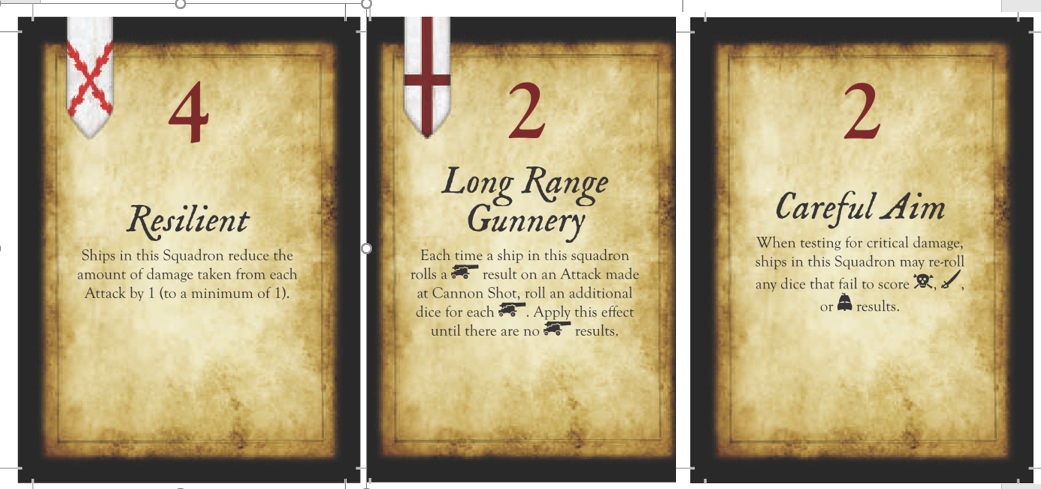 The reason why lists are so important is the fact that this is not a ship wargame, it’s a true squadron wargame and this is not a subtle difference. Games like the old Sails of Glory did have multiple ships her side however for them to play a unit was problematic within the mechanics of the game. When you look at all the elements of the game you can see how building an effective squadron and having their capabilities complement one another is the key to success.
The reason why lists are so important is the fact that this is not a ship wargame, it’s a true squadron wargame and this is not a subtle difference. Games like the old Sails of Glory did have multiple ships her side however for them to play a unit was problematic within the mechanics of the game. When you look at all the elements of the game you can see how building an effective squadron and having their capabilities complement one another is the key to success.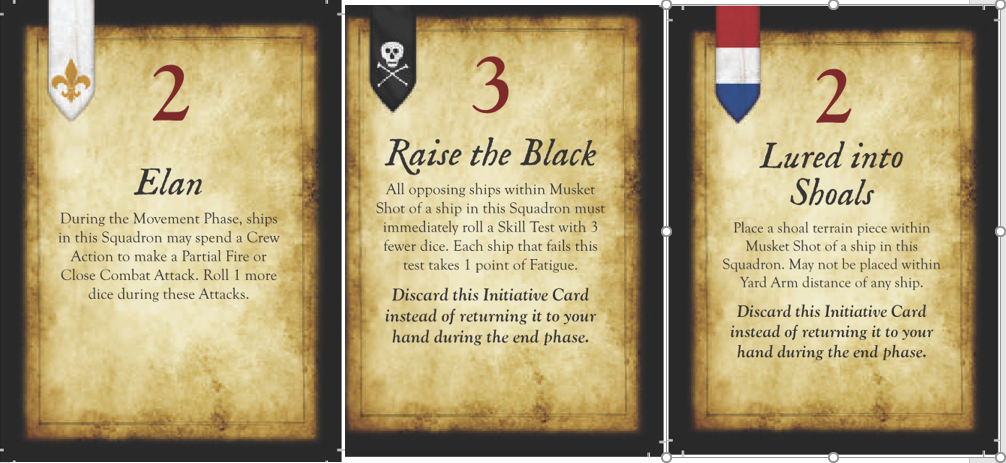 Another great aspect of the game is how it can allow you to play some small actions to very large fleet engagements. I plan to buy a bunch of 1st thru 3rd Rates when they are available for single ship purchase so I can play some of the larger fleet engagements of the period.
Another great aspect of the game is how it can allow you to play some small actions to very large fleet engagements. I plan to buy a bunch of 1st thru 3rd Rates when they are available for single ship purchase so I can play some of the larger fleet engagements of the period.
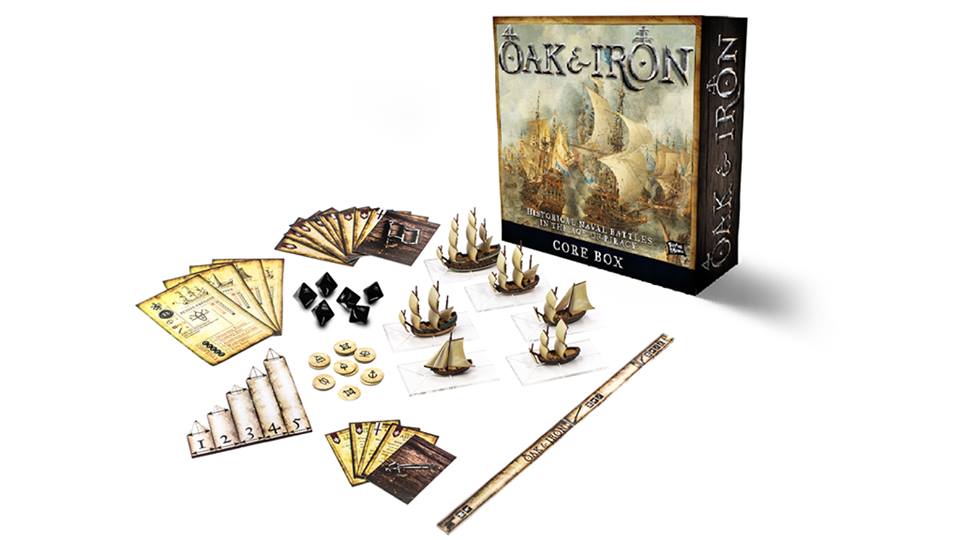 Big Seas, Little Ships
Big Seas, Little Ships
I have played a demo of Oak and Iron with Mike Tunez and read the rules dozens of times, however, I did not realize how deep and broad this game was until I was able to see a copy of all the cards included with the game. What Firelock has created here is a real fleet-level game with a ton of flavor where its dedication to the actual history is sewn into the DNA of the game. This is no small feat and I think every naval grog will love this game and those of you who are not into naval games I would recommend you try Oak and Iron if you want to see what all the buzz is about.
